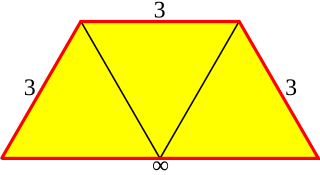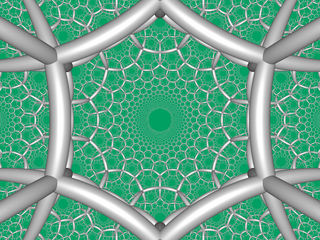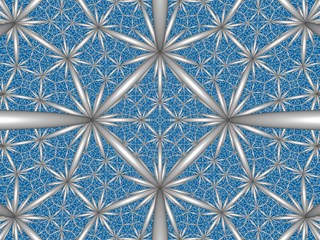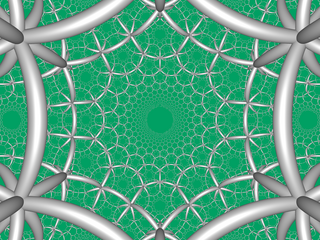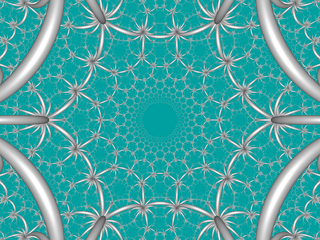In geometry, an apeirogonal tiling is a tessellation of the Euclidean plane, hyperbolic plane, or some other two-dimensional space by apeirogons. Tilings of this type include:

Geometry is a branch of mathematics concerned with questions of shape, size, relative position of figures, and the properties of space. A mathematician who works in the field of geometry is called a geometer.

A tessellation of a flat surface is the tiling of a plane using one or more geometric shapes, called tiles, with no overlaps and no gaps. In mathematics, tessellations can be generalized to higher dimensions and a variety of geometries.

In geometry, an apeirogon is a generalized polygon with a countably infinite number of sides. It can be considered as the limit of an n-sided polygon as n approaches infinity. The interior of a linear apeirogon can be defined by a direction order of vertices, and defining half the plane as the interior.
- Order-2 apeirogonal tiling, Euclidean tiling of two half-spaces
- Order-3 apeirogonal tiling, hyperbolic tiling with 3 apeirogons around a vertex
- Order-4 apeirogonal tiling, hyperbolic tiling with 4 apeirogons around a vertex
- Order-5 apeirogonal tiling, hyperbolic tiling with 5 apeirogons around a vertex
- Infinite-order apeirogonal tiling, hyperbolic tiling with an infinite number of apeirogons around a vertex

In geometry, an order-2 apeirogonal tiling, apeirogonal dihedron, or infinite dihedron is a tiling of the plane consisting of two apeirogons. It may be considered an improper regular tiling of the Euclidean plane, with Schläfli symbol {∞, 2}. Two apeirogons, joined along all their edges, can completely fill the entire plane as an apeirogon is infinite in size and has an interior angle of 180°, which is half of a full 360°.

In geometry, the order-3 apeirogonal tiling is a regular tiling of the hyperbolic plane. It is represented by the Schläfli symbol {∞,3}, having three regular apeirogons around each vertex. Each apeirogon is inscribed in a horocycle.

In geometry, the order-4 apeirogonal tiling is a regular tiling of the hyperbolic plane. It has Schläfli symbol of {∞,4}.
